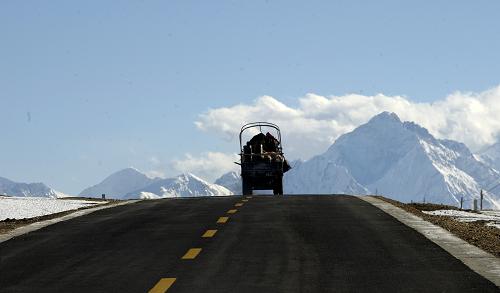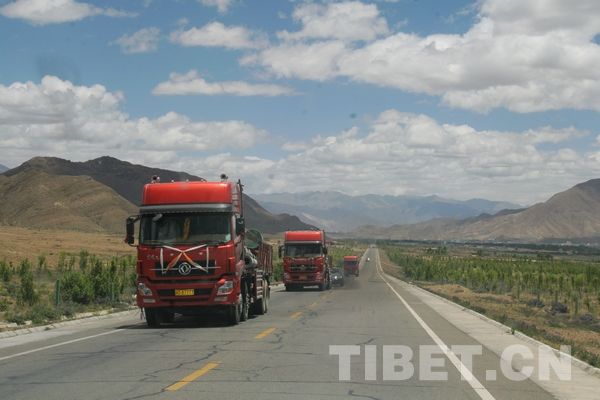Tibet reinvents itself as a channel to South Asia
Prakash, a thangka dealer from Nepal, brought over 1,000 of the scroll paintings to the China Tibet Tourism and Culture Expo, after the 200 thangka he brought last year were quickly snapped up.
"China has become such an important market for me that I value the expo more than anything," Prakash said.
This expo, the third, took place in Lhasa, Tibet, and lasted for a whole week. It attracted around 400 overseas guests from 15 countries including France, Nepal, Pakistan, the Republic of Korea and the United States. Over 200 of the merchants were from Nepal with many others from nearby Asian countries.
Tibet Autonomous Region in southwest China is shaking off its reputation as remote and inaccessible, and gaining a new status as a warm and welcoming destination.
ROOF OF THE WORLD
Tibet's distinctive culture and the tourists it attracts have been vital in turning the region into the main trade channel between China and South Asia.
Faced with a wide range of Tibetan goods at the expo, Prakash decided to purchase a number of items with the money he had just made to sell back in Nepal.
According to Tibet's department of commerce, this year there were more than double the number of Nepalese dealers and companies at the expo than last year's event. Buddha figures, copperware and carpets are their most common commodities.
Nepal has been Tibet's largest trading partner since 2006 and, according to Lhasa customs, more than 10 billion yuan (1.5 billion U.S. dollars) flowed between the two in 2014, more than 90 percent of the autonomous region's total trade.
The only land port between China and India in Tibet's Xigaze City saw an exchange of goods worth more than 100 million yuan for the first time in 2014, a quite dramatic increase on a trade volume of around 1.5 million yuan when the frontier reopened in 2006.
Tibet is adjacent to Qinghai, Sichuan, Xinjiang and Yunnan -- all deeply important to China's Belt and Road Initiative.
Justin Yifu Lin, former chief economist at the World Bank, now with Peking University National School of Development, sees Tibet's unique geographical advantages as key to regional interconnectivity and cooperation.
Lin also pointed out that exchanges of tea, salt and ponies between Tibet and Asian countries along the ancient Tea Horse Road have been going on for around 1,000 years, forming the perfect foundation for modern economic activity.
Tibet reported a total export-import volume of over 5.66 billion yuan last year, engaging in bilateral trade with 77 countries and regions.
CONNECTIONS, CONSERVATION
With increasing investment from public and private sectors flooding into the region, infrastructure construction is proceeding more quickly than ever before, most notably in terms of transportation, water conservancy and energy.
Himalaya Airlines, a China-Nepal joint venture, was registered in Nepal this year and has started daily flights.
Shan Jixiang, director of the Palace Museum in Beijing, sees tourism as a shortcut to increased Tibet's connectivity with South Asia. The autonomous region received over 20 million domestic visitors in 2015, up 5.5 percent and accounting for about 27 percent of the region's GDP.
Once integrated with other industries, culture and tourism will create new economic growth sources, according to chairman of Tibet's regional government Losang Jamcan.
Karan Sharma, a travel agent from India and a first-timer at the expo, pins high hopes on his company's New Delhi-Kathmandu-Tibet tour, and after only one day tour in Lhasa, he felt even more confident.
"I never thought Lhasa would be so modern. The city's infrastructure is so much improved," he said. "Better links between Tibet and South Asia will definitely bring strong opportunities in regional tourism and other industries."
Your Comment
Name E-mailRelated News
-
;
-
-

-
Expert: Tibet should speed up South Asia land road construction
Tibet should take an active part in the "One Belt and One Road" initiative, speed up construction of the over land road to South Asia and involve in the South Asia economic circle.
-
-
-

-
Tibet to establish "China-South Asia Standards Research Center"
The Tibet Autonomous Region Tibet will establish a “China-South Asia Standards Research Center” to help with implementation of the “One Belt, One Road” strategy.
-
-
-

-
Chairman: Tibet to launch construction of corridor to South Asia
Losang Gyaltsen, Chairman of the Tibet Autonomous Region, said the railway is already contributing toward Tibet’s opening up.
-
Based in Lhasa, Tibet Vista is a Tibet travel agency that specialized in Tibet permit, and Tibet tours for both private and group travelers at a local price!
•4 Days Lhasa City Group Tour from USD 460 •8 Days Everest Base Camp Group Tour from USD 850 •15 Days Mt.Kailash Group Tour from USD 1780 •2016 Tibet Train Tours from Beijing, Shanghai, Chengdu, Xining,etc










